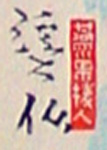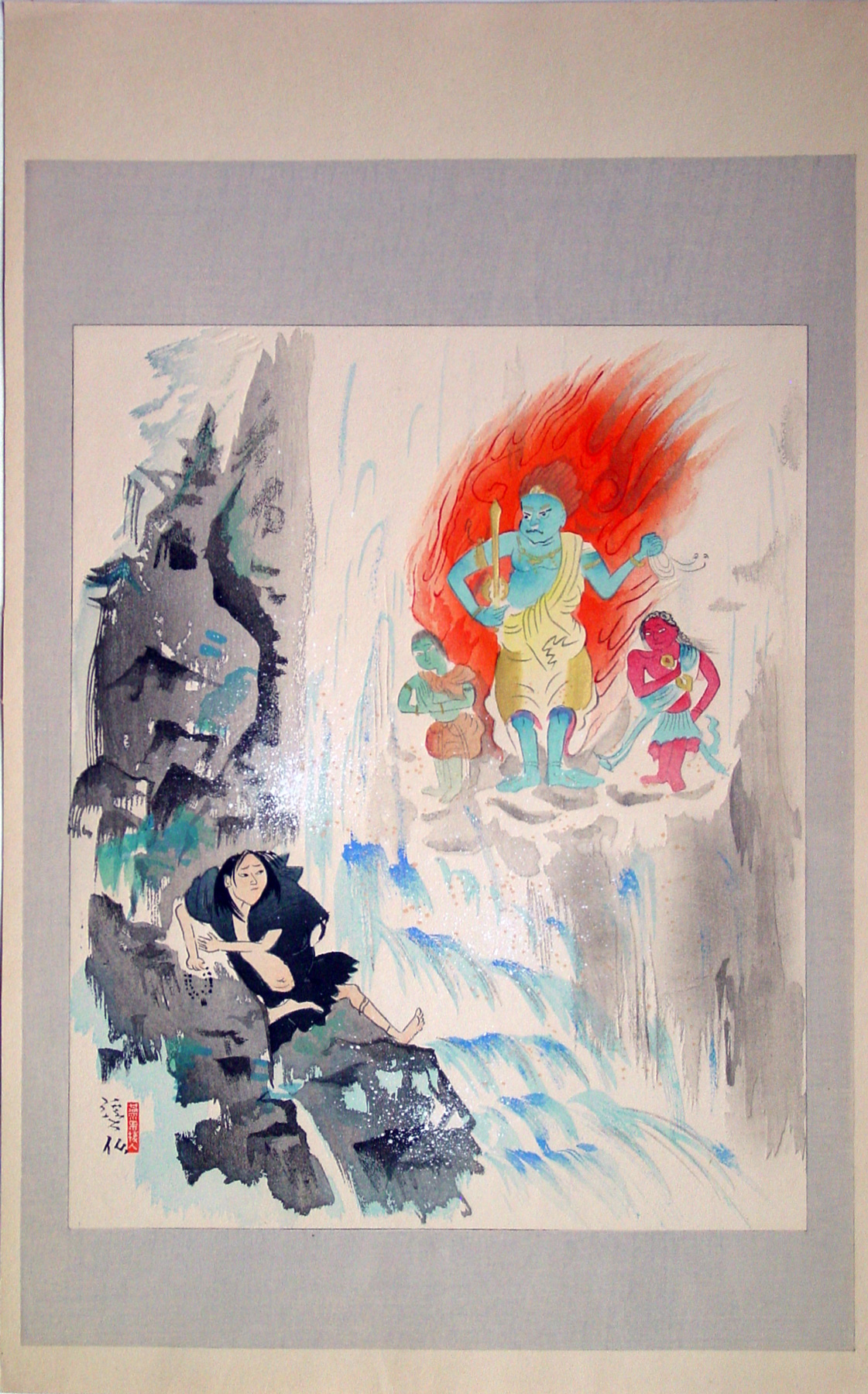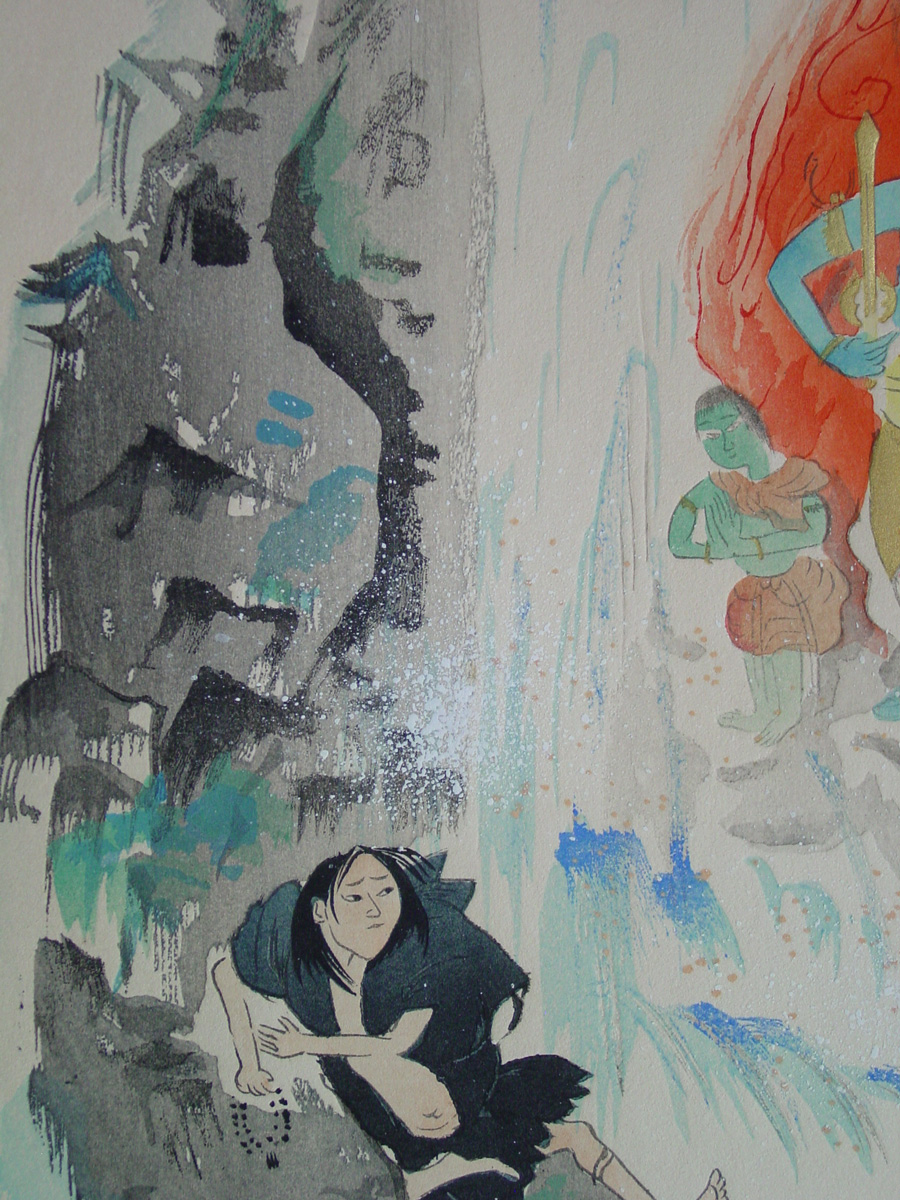About This Print
This print by Tomita Keisen (1879-1936) depicts the priest Mongaku atoning for his sins by standing under Nachi waterfall inwinter. About to die, he is rescued by the god Fudō Myō-ō(Buddhist Diety of Fire.)The Story of the Priest Mongaku and the God FudōThe priest Mongaku is referred to in Chikamatsu's 1714 bunraku play Fair Ladies at a Game of Poem Cards (Kaoyo Utagaruta). The character Takeguchi, who wishes to atone for his sins, invokes the story of Mongaku as follows:The story of the priest Mongaku is told in the unattributed play Nachi-no-Take Chikai no Mongaku, “The Priest Mongaku at the Waterall of Nachi". |
Endo Morito, the son of a minor courtier became infatuated with thebeautiful Kesa Gozen, the faithful young wife of Watanabe Wataru, apalace guard. She rejected his advances but he was so persistent thatshe pretended to agree to his proposal on the condition that he firstkill her husband. Kesa concocted a plan where Morito was to steal intoWataru’s room by night. That night, Kesa cut off her long hair and laydown in the darkness in her husband’s bed. At midnight Morito arrivedand felt in the darkness until he found the sleeping figure. Heimmediately cut the head off and ran off. He was horrified to find thathe had cut off the head of Kesa Gozen. He renounced the world andbecame a monk. For three years he attempted to atone for his crime bythe harshest austerities, standingunder the icy Nachi waterfall inwinter. He was frozen and about to expire, but was saved by Fudō Myō-ō(Buddhist Diety of Fire, depicted with a sword in one hand and a ropein the other) and his Acolytes, Kongara and Seitaka.2 |
Woodblock Print Supplements to the Complete Works of Chikamatsu
One of 18 prints published from 1922 to 1923 as part of the celebration of the two-hundredth anniversary of the death of Chikamatsu Manzaemon (1623-1724), perhaps the greatest dramatist in the history of the Japanese theater. Each design illustrates a scene or character from one of Chikamatsu’s famous works. For more details on this series go to Woodblock Print Supplements to the Complete Works of Chikamatsu.
2 Robyn Buntin of Honolulu gallery website http://www.robynbuntin.com/Articles/PDFs/KesaGozen.pdf
Print Details
| IHL Catalog | #147A |
| Title or Description | The Diety Fudō and the Priest Mongaku |
| Series | Woodblock Print Supplements to the Complete Works of Chikamatsu Dai Chikamatsu zenshu furoku mokuhan 大近松全集 付録木版 |
| Artist | Tomita Keisen (1879-1936) |
| Signature |  |
| Seal | unread red artist's seal |
| Publication Date | between 1922-1923 |
| Edition | likely first edition, but the number of editions issued is unknown |
| Publisher | Dai Chikamatsu zenshū kankōkai 大近松全集刊行会 (the Complete Work of Chikamatsu Publishing Association) |
| Carver | Yamagishi Kazue 1893-1996 |
| Printer | Nishimura Kumakichi |
| Impression | excellent |
| Colors | excellent |
| Condition | excellent |
| Miscellaneous | all prints from this series printed on a light tan-colored paper |
| Genre | shin hanga (new prints) |
| Format | dai-oban |
| H x W Paper | 17 3/4 x 11 1/8 in. (45.1 x 28.3 cm) |
| H x W Image | 15 1/8 x 10 5/8 in. (38.4 x 27 cm) measurement includes gray border |
| Collections This Print | The Tsubouchi Memorial Theatre Museum of Waseda University 201-0393 |
| Reference Literature | |



